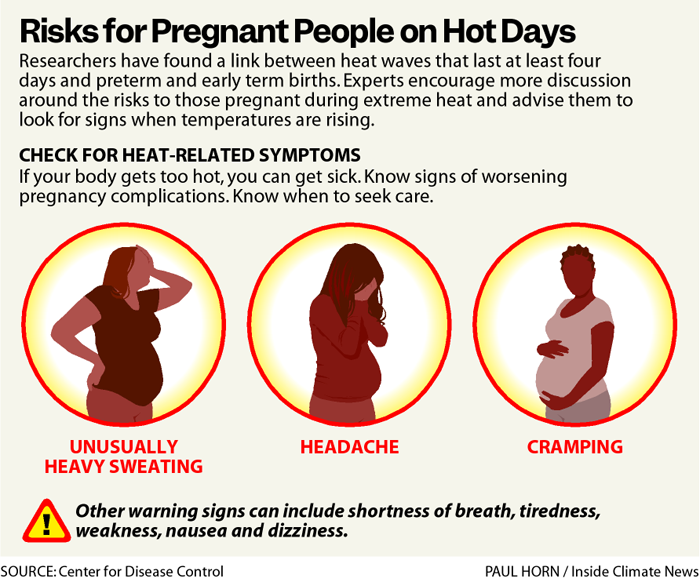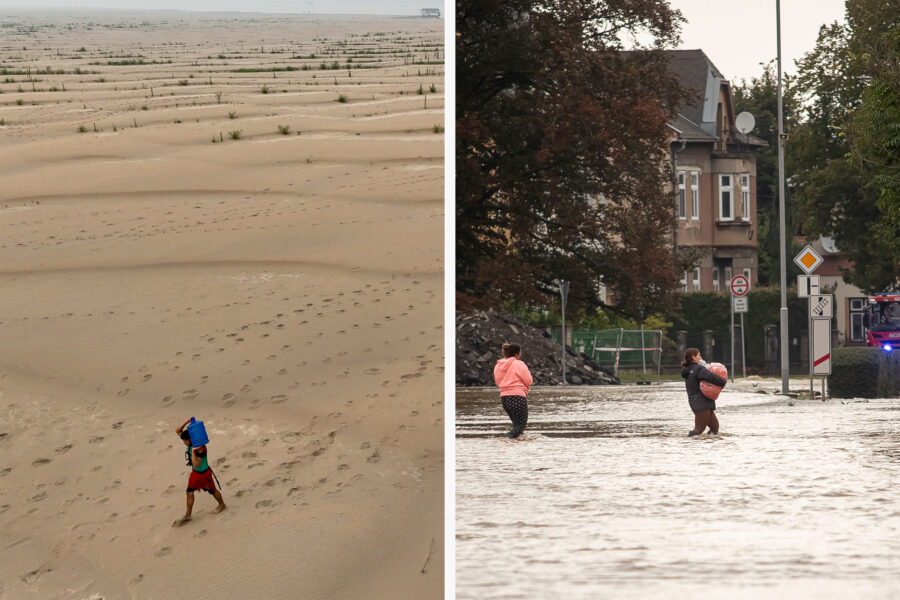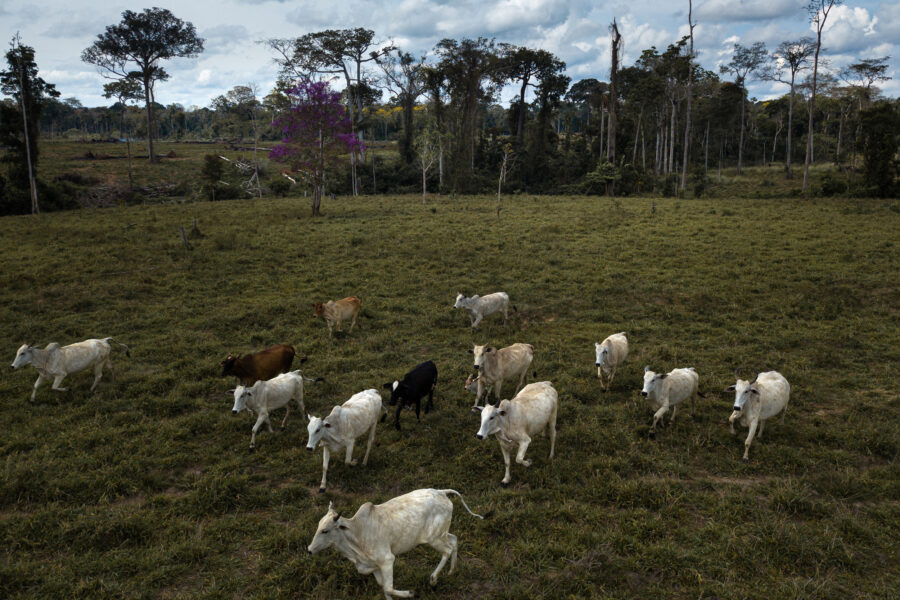For Pregnant People, Heat Waves Bring An Increased Risk of Preterm and Early Term Babies, Study Finds
PHILADELPHIA—Jaquanna Lomax finished her training classes as a doula just last month, but as summer approaches and she awaits her first professional delivery, she’s already started thinking about one potential challenge for new moms that wasn’t covered much during her schooling—the heat.
Lomax, a 36-year-old mother of two herself who’s based in Philadelphia, has spent years coping with searing summers in the Northeast, which, because of climate change, has long been the nation’s fastest warming region. She delivered one of her own children in the summer and knows how brutal the third trimester of pregnancy can be under a baking sun.
“My concern mostly is, because of climate change, that people are not more aware of how they’re feeling or thinking about hydration, nutrients,” said Lomax, during an interview in the University City section of Philadelphia. “So I just want to make sure mothers are more aware—not necessarily being a health fanatic, but just thinking about how they’re feeling for today.”
We’re hiring!
Please take a look at the new openings in our newsroom.
See jobsAccording to a new peer-reviewed study in the Journal of American Medical Association, Lomax’s concerns about pregnant people and high temperatures seem well placed: Researchers have found that heatwaves are linked to an increased risk of preterm and early births among pregnant people, especially those with low incomes.
The study examined more than 50 million births from the nation’s 50 largest metropolitan areas over the 25 years from 1993 to 2017. Researchers found that during heat waves of up to four days in those areas—defined by researchers as those days when temperatures were in the 97.5th percentile—the risk of early or preterm births grew by 1 percent for every 1 degree Celsius (or 1.8 degrees Fahrenheit) over the average temperature.
In other words, if a heat wave produced temperatures that were 4 degrees Celsius higher than average, the risk of an early or preterm birth increased by roughly 4 percent. The researchers also found that a range of other factors affected the risks of early and preterm births, including the age of mothers (there were “stronger associations among the youngest and oldest mothers,” researchers wrote), those who are “members of racial and ethnic minority groups, and mothers with lower educational achievement.”
Howard J. Chang, a professor of biostatistics and bioinformatics in the Rollins School of Public Health at Emory University and one of the authors of the study, said that he and his co-researchers hope that their work might bring more attention to the perils of heat waves for more than just obstetricians and expectant mothers.
“Our study focused, of course, on pregnant people, but overall I think that the general public should be aware of very hot days,” Chang said in an interview. “How to protect themselves and watch out for signs of dehydration or heat illnesses. Public health and medical professionals can also use this as part of their communication, as they see patients and prepare for the future where we might see more hot days.”

The researchers defined preterm births as those that occurred between 28 weeks and 36 weeks of pregnancy; early term births were those that occurred between 36 weeks and 38 weeks. The American College of Obstetricians and Gynecologists defines a full-term birth as occurring between 39 weeks and 40 weeks and six days.
Public health researchers say that both preterm and early term babies have rates of higher infant mortality and birth defects; those babies also are at greater risk of suffering conditions like heart attacks and strokes later in life.
Experts acknowledge that the study of how heat affects expectant mothers is still very much an evolving field of research. But those who are examining other ways that climate change affects pregnancy and fetal development say that the role of heat should not be discounted.
Kimberly Terrell, a research scientist at the Tulane Environmental Law Clinic, served as the lead author of a study published in March that identified correlations between air pollution and low birth weights and preterm births in the area of Louisiana known as “Cancer Alley”—an 85-mile stretch of land from New Orleans to Baton Rouge that is home to roughly 200 petrochemical plants and where residents have disproportionately high rates of cancer.
Terrell said that, while her study did not focus on heat, both high temperatures and air pollution may be part of what she called a “multilayered burden of risk”—environmental harms that lead to health disparities and which are often disproportionately borne by people of color and those with low incomes.
“Oftentimes we see decision makers kind of cherry pick the risk factor that they want to focus on, right? So, we often see lifestyle factors being pointed to as explanations for health disparities,” Terrell said. “We have to consider all the environmental risk factors, holistically. If someone lives in a hurricane-prone area, that’s not a reason to ignore pollution. And if somebody lives in a polluted neighborhood, that’s not a reason to ignore the risks of heat stress. All of these factors warrant attention, and action to try to reduce this burden.”
“In Louisiana, we tend to associate ozone with heat,” Terrell said. “So during the summertime, sometimes we’ll be watching the weather forecast and you might even hear the meteorologist say, ‘Oh, it’s going to be a high ozone day. Stay indoors, avoid strenuous activities outside during the hottest hours because there’s high concentrations of ground-level ozone.
“Ozone is a type of pollutant that its formation is facilitated by heat,” she said. “And so even when it comes down to kind of like the nitty-gritty technical part of it, there’s very much a connection between extreme heat and pollution linked to things like preterm birth and low birth weight. There are certainly other pollutants that exist independent of temperature and heat. But ozone is an important illustration of how these issues can intersect.”
Shruthi Mahalingaiah, an assistant professor of environmental reproductive and women’s health at Harvard T.H. Chan School of Public Health, co-authored a commentary in the Journal of American Medical Association in which she and two colleagues wrote that studies like this one help to illustrate “the association between a variety of health outcomes and environmental hazards that are of increasing importance in the context of climate change.”
In the commentary, Mahalingaiah and the co-authors wrote that “while associations of extreme heat with hospitalizations, suicides, mortality, and other health outcomes among older adults and the general population are increasingly well understood, the association of extreme heat with time to conception, pregnancy loss, and general health of pregnant individuals and infants are less-often discussed.”
“The inclusion of obstetrical, maternal, and fetal outcomes in our conversation around extreme climate events is critical,” Mahalingaiah said in an interview.
Heat and pregnancy is something Rupa Basu could not stop thinking about when she was pregnant, so she began researching it. Basu, who is a research scientist at California’s Environmental Protection Agency, published her first paper in 2010.
She said now “if you look at the literature, it’s all there. But here’s where I think we need work: the public health messaging.”
Basu said it is important that studies like this are published in medical journals because they’re read by many clinicians. “And we have this knowledge in the scientific community. But we have to get this out to caretakers, to clinicians, to other people,” she added.
“I don’t think we need more and more and more and more studies,” she said. “I think we need to be better about actually sharing the results with people outside of the scientific community.”
In Philadelphia, Jaquanna Lomax was attending a symposium about heat and maternal and child health at Drexel University’s Dornsife School of Public Health last week. She listened as researchers, clinicians and advocates talked about the adverse effects of heat in a steadily warming world.
The event happened to fall on National Heat Awareness Day, and Lomax sat in an auditorium in Nesbitt Hall and nodded along as speakers talked about the hazards of high temperatures.
Lomax said that while many people don’t think of heat as a potential danger for expectant mothers, she believes that it one day will be a core part of prenatal health discussions. She said that she is constantly encouraging pregnant people to stay hydrated and not wait to drink until they are thirsty.
“I always have a water, or a juice, or something,” she said. Then, as if to demonstrate that she practices what she preaches, she opened her black handbag, revealing a small bottle of apple juice.
She said she hopes that any pregnant person—whether they are feeling their internal temperatures rise in the Northeast or elsewhere in the warming world—does the same.
“They always say, ‘If you can’t take care of yourself, how can you pour into someone else?’” Lomax said. “So we have to take care of ourselves first in order to take care of the womb.”
Share this article
Disclaimer: The copyright of this article belongs to the original author. Reposting this article is solely for the purpose of information dissemination and does not constitute any investment advice. If there is any infringement, please contact us immediately. We will make corrections or deletions as necessary. Thank you.







